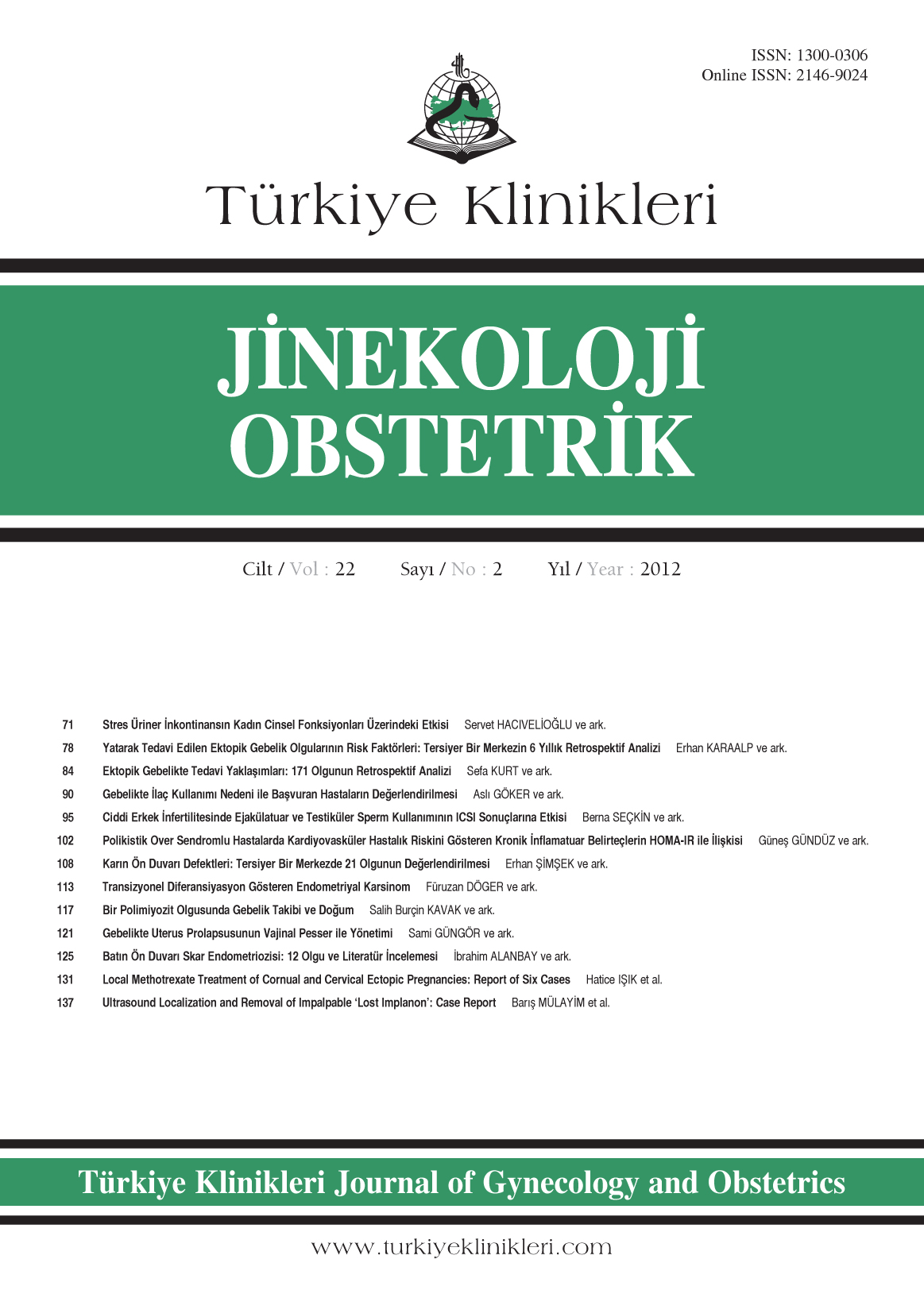Open Access
Peer Reviewed
ORIGINAL RESEARCH
2306 Viewed856 Downloaded
Management of Ectopic Pregnancies: Retrospective Analysis of 171 Cases
Ektopik Gebelikte Tedavi Yaklaşımları: 171 Olgunun Retrospektif Analizi
Turkiye Klinikleri J Gynecol Obst. 2012;22(2):84-9
Article Language: TR
Copyright Ⓒ 2020 by Türkiye Klinikleri. This is an open access article under the CC BY-NC-ND license (http://creativecommons.org/licenses/by-nc-nd/4.0/)
ÖZET
Amaç: Hastanemizde son 3 yılda tedavi edilen 171 ektopik gebelik (EG) olgusundaki risk faktörleri, tedavi yöntemleri ve sonuçlarını değerlendirmektir. Gereç ve Yöntemler: Hastanemizde, Haziran 2008-Haziran 2011 tarihleri arasında EG tanısıyla tedavi edilen 171 olgu retrospektif olarak değerlendirildi. Olguların kayıtlarından demografik özellikleri, tedavi şekilleri, tedaviyi etkileyen etkenler ve EG için risk faktörleri araştırıldı. Bulgular: Üç yıllık sürede, EG tanısı alan 171 olgu vardı. En sık başvuru nedeni olarak vajinal kanama ve ağrı izlenirken olguların %19,2 (33 olgu)'si insidental olarak tanı aldı. EG için en sık lokalizasyon %90 (81 olgu) ile ampuller bölge, en sık izlenen risk faktörleri %19,8 (34 olgu) ile geçirilmiş abdomino pelvik cerrahi ve %9,3 (16 olgu) ile rahim içi araç kullanımı olarak saptandı. Olguların %52,04 (89 olgu)'üne primer cerrahi, %34,5 (59 olgu)'ine tek doz metotreksat (MTX) tedavisi, %13,4 (23 olgu)'üne izlem tedavisi uygulandı. Tüm olgularda yaş aralığı 15-45'tir. Her 3 tedavi kolunda (cerrahi, MTX, izlem) sosyodemografik özellikler benzerdi. Sonuç: Tedaviyi etkileyen en önemli etkenler başvuru anındaki hemodinamik durum, ?-hCG düzeyi ve gebelik haftasıdır. Erken tanı ve konservatif tedavi yaklaşımları, tubal anatomi ve fonksiyonu koruyarak, EG tedavisi sonrası en önemli risk olan rekürren EG insidansını azaltacaktır.
Amaç: Hastanemizde son 3 yılda tedavi edilen 171 ektopik gebelik (EG) olgusundaki risk faktörleri, tedavi yöntemleri ve sonuçlarını değerlendirmektir. Gereç ve Yöntemler: Hastanemizde, Haziran 2008-Haziran 2011 tarihleri arasında EG tanısıyla tedavi edilen 171 olgu retrospektif olarak değerlendirildi. Olguların kayıtlarından demografik özellikleri, tedavi şekilleri, tedaviyi etkileyen etkenler ve EG için risk faktörleri araştırıldı. Bulgular: Üç yıllık sürede, EG tanısı alan 171 olgu vardı. En sık başvuru nedeni olarak vajinal kanama ve ağrı izlenirken olguların %19,2 (33 olgu)'si insidental olarak tanı aldı. EG için en sık lokalizasyon %90 (81 olgu) ile ampuller bölge, en sık izlenen risk faktörleri %19,8 (34 olgu) ile geçirilmiş abdomino pelvik cerrahi ve %9,3 (16 olgu) ile rahim içi araç kullanımı olarak saptandı. Olguların %52,04 (89 olgu)'üne primer cerrahi, %34,5 (59 olgu)'ine tek doz metotreksat (MTX) tedavisi, %13,4 (23 olgu)'üne izlem tedavisi uygulandı. Tüm olgularda yaş aralığı 15-45'tir. Her 3 tedavi kolunda (cerrahi, MTX, izlem) sosyodemografik özellikler benzerdi. Sonuç: Tedaviyi etkileyen en önemli etkenler başvuru anındaki hemodinamik durum, ?-hCG düzeyi ve gebelik haftasıdır. Erken tanı ve konservatif tedavi yaklaşımları, tubal anatomi ve fonksiyonu koruyarak, EG tedavisi sonrası en önemli risk olan rekürren EG insidansını azaltacaktır.
ABSTRACT
Objective: To evaluate the risk factors, treatment modalities and the results of 171 ectopic pregnancies (EP) treated in our hospital the last 3 years. Material and Methods: In June 2008-2011; 171 patients with a diagnosis of EP were retrospectively evaluated in our hospital. Patients\\ demographic characteristics, treatment modalities, and factors affecting treatment and the risk factors for EP were investigated from transcriptions of the patients. Results: The three-year period, 171 patients were diagnosed with EP. the most common reasons for application were the vaginal bleeding and pain; in 19.2% of cases (33 cases) were diagnosed incidentally. The most common location for EP 90% (81 cases) was ampulla, the most common risk factors were 19.8% (34 cases) the previous abdomino pelvic surgery and with 9.3% (16 cases) intrauterine device use. 52.04% of the patients\\ were treated with (89 cases) primary surgery, 34.5% (59 cases) were treated with single-dose methotrexate (MTX) therapy, 13.4% (23 cases) were treated with follow-up. In all cases, age range was 15-45 for each of the 3 treatment (surgery, MTX, follow-up); demographic characteristics were similar. Conclusion: The most important factors affecting treatment were hemodynamic status at admission, ?-hCG level and week of pregnancy. Early diagnosis and conservative treatment approaches, while preserving tubal anatomy and function, will reduce the incidence of recurrent EP which is the most important risk after EP treatment.
Objective: To evaluate the risk factors, treatment modalities and the results of 171 ectopic pregnancies (EP) treated in our hospital the last 3 years. Material and Methods: In June 2008-2011; 171 patients with a diagnosis of EP were retrospectively evaluated in our hospital. Patients\\ demographic characteristics, treatment modalities, and factors affecting treatment and the risk factors for EP were investigated from transcriptions of the patients. Results: The three-year period, 171 patients were diagnosed with EP. the most common reasons for application were the vaginal bleeding and pain; in 19.2% of cases (33 cases) were diagnosed incidentally. The most common location for EP 90% (81 cases) was ampulla, the most common risk factors were 19.8% (34 cases) the previous abdomino pelvic surgery and with 9.3% (16 cases) intrauterine device use. 52.04% of the patients\\ were treated with (89 cases) primary surgery, 34.5% (59 cases) were treated with single-dose methotrexate (MTX) therapy, 13.4% (23 cases) were treated with follow-up. In all cases, age range was 15-45 for each of the 3 treatment (surgery, MTX, follow-up); demographic characteristics were similar. Conclusion: The most important factors affecting treatment were hemodynamic status at admission, ?-hCG level and week of pregnancy. Early diagnosis and conservative treatment approaches, while preserving tubal anatomy and function, will reduce the incidence of recurrent EP which is the most important risk after EP treatment.
MENU
POPULAR ARTICLES
MOST DOWNLOADED ARTICLES





This journal is licensed under a Creative Commons Attribution-NonCommercial-NoDerivatives 4.0 International License.











